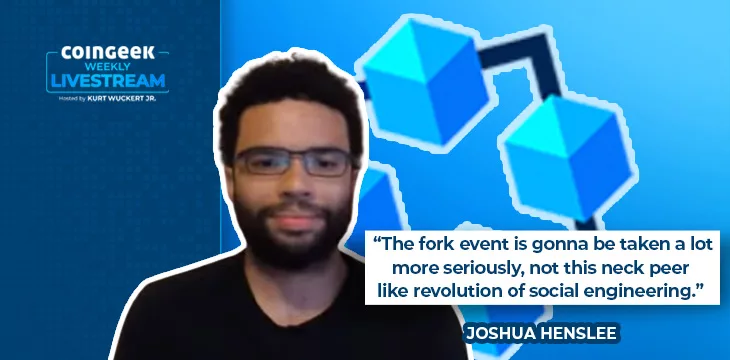|
Getting your Trinity Audio player ready...
|
Both Kurt Wuckert Jr. and Joshua Henslee attended the London Blockchain Conference recently, so it’s only fitting that they would have a conversation reflecting on what they learned and what’s generally happening in the ecosystem. That’s what this CoinGeek Weekly Livestream episode was about.
Reflections on the London Blockchain Conference
Wuckert begins by asking Henslee for his opinion on the London Blockchain Conference.
Henslee says he didn’t attend too many presentations and was mainly focused on networking. He met lots of great people and left feeling more optimistic than he went in. He thinks the rebranding worked well, and lots of people were interested in BSV blockchain after being drawn in by the general ‘blockchain’ theme. He found it encouraging that Dr. Craig Wright still fills rooms even after all these years. Clearly, people are still listening.
What is going on with Bitmap?
Wuckert then asks Henslee about a recent development on BTC; Bitmap. What is it, and how does it work?
Henslee says it’s another viral protocol that has taken off on BTC, much like Ordinals did a few months back. It involves text inscriptions rather than images, and because of that, we’re not seeing the same congestion and fee increases we did before. People are rallying around it, so obviously, the market sees value in it.
Wuckert wonders if too many of these protocols might create inflation in the assets and boredom with the concept. Henslee says this is not happening so far. Instead, it’s “exponential and perpetual.”
Measuring Bitcoin’s value
Henslee and Wuckert then veer into a more general conversation about how to measure Bitcoin’s value. Henslee says it’s subjective. People find value in being able to inscribe something on a cave wall forever.
Wuckert still can’t shake the feeling that the proverbial “knife in the back” is coming. He lived through it in the block-size wars, and he knows all too well that BTC Core will stop at nothing in their fanaticism. He thinks there’ll be a fork at some point.
Henslee thinks we might be beyond that point already. Unlike in 2017, there’s too much money involved this time, and there are many more people. Nuking things like Ordinals is essentially asset seizure, and it won’t go down well, he says.
Ultimately, Henslee believes that everything will end up on one blockchain, which will be one of the Bitcoin protocols, but he isn’t sure which one yet. From a technical standpoint, it should be BSV blockchain, but many people are choosing BTC to experiment on, so anything could happen.
Wuckert notes that it’s simple enough to create bigger blocks in the beginning, but it’s not that easy; other elements like Script will be needed, and that has been stripped out of BTC. Essentially, this view agrees that BSV blockchain should ultimately win from a technical standpoint.
Could Ordinals on BTC be the trigger for a big move to BSV Ordinals later?
A viewer of the CoinGeek Weekly Livestream asks this question. Are Ordinals a Trojan Horse? Some BTC advocates on social media have certainly painted them that way, with some even causing BSVers to be behind it.
Henslee thinks that this may happen, but he’s not sure. Some people don’t care about the BSV blockchain, while others still believe in scalable Bitcoin. Therefore, it’s possible that some people will move camps while others will remain where they are, come what may.
However, he does note that it is BSV blockchain entrepreneurs who have cleaned up and made a killing during the Ordinals’ mania. Why so? Because they put in the work in the last few years and were ready when the moment came.
Will BSV win?
This is another viewer’s question, and Henslee says it could, but someone has to build something different. “We need to make something that people want,” he reiterates, having said this on his own channel many times. He doesn’t believe in attracting customers who don’t have the coin right now but rather in building things for people who already have it and enticing them to spend it.
Why do people build on BTC? Liquidity is a big factor, and so is manpower. The availability of the coin on exchanges has a role to play in both.
That said, BSV blockchain transaction records keep getting bigger, albeit the overall daily trend is slightly down. Wuckert says he doesn’t have any inside information on Teranode, but the team is the strongest it has ever been, and BSV blockchain is well-placed to scale unboundedly when it’s released.
In closing, the two discuss what the SEC is up to. Henslee says he can’t figure it out but thinks they’re going after smaller players to build the case before they go after the big ones. Will they go after the Ethereum Foundation at some point? Time will tell.
Watch: Ordinals on BSV! Luke Rohenaz explains their Utility and Value on the CoinGeek Weekly Livestream

 12-08-2025
12-08-2025 





